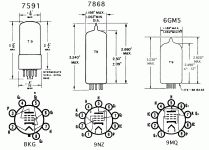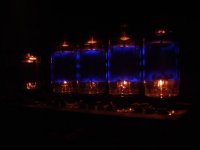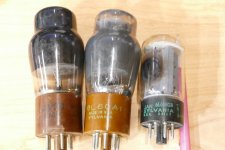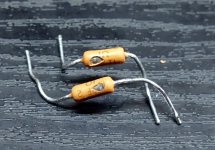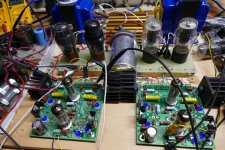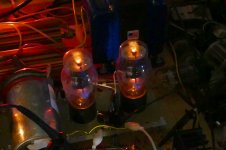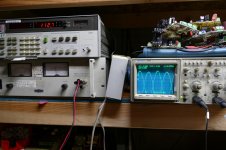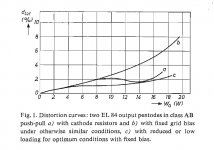According to my Russian valve expert, (OEM manufacturer), the secret is in the GLASS.the 7868 mentioned. The newer version are expensive and last only a few hours
We had a long interview this summer, and Russian manufacturing is all (apparently) afflicted by the same disease, which is why none of the (recently made) valves last very long. 🙄
I cringe whenever I see the 7868 mentioned. The newer version are expensive and last only a few hours in my Fisher receiver (which mostly sits on a shelf unused.)
My Sylvania 6GM5's have been powered up (& sometimes run hard) most every day 2-4 hours for past 6 months. Most outlets still have them- $29.95. Thought someone made adapter sockets, but couldn't find. If point to point, simple wiring conversion could be done.
Attachments
I cringe whenever I see the 7868 mentioned. The newer version are expensive and last only a few hours in my Fisher receiver (which mostly sits on a shelf unused.)
If you reduce the screen voltage down to 125V, you could use the 6JA5 Vertical Amp tube, with a socket change.
$8
and better curves besides.
For more than 400V B+, there is the 12/6GE5 12/6JN6. Socket change. 125V screens.
$6 and fairly good curves too, lower gm. A 21HB5 would get the same gm as 7868 at 60 mA.
No UL/ Ultralinear mode with these however. These all use higher heater current than the 7868.
Last edited:
The 6P41S tube has the same base connection as the 7868 (slightly higher heating consumption) and can be used in the triode and UL connection up to Ub ~ 350-360V, and in the pentode up to Ua ~ 550V (I tried it up to Ua ~ 600-620V! ) if Ug2 is limited to ~ 150-175V (usually less than ~ 200V, or best stabilized).
Geometrically, the size of the plate of the 6P41S tube is approximately equal to that of the tube 7868, so the factory data on the maximum plate dissipation of Pa = 14W can be considered very conservative, ie that it refers to the permanent load in the vertical deflection of the TV.
The need for a slightly higher negative bias voltage for the 6P41s may require a different design of the negative voltage rectifier itself (perhaps a doubler?), as well as a new setting of the quiescent current goes without saying.
Through practice, I found that the 6P41S tubes are durable in operation, and the output power of the amplifiers in which they replaced the 7868 tube remained approximately the same with a similar level and structure of distortion.
Geometrically, the size of the plate of the 6P41S tube is approximately equal to that of the tube 7868, so the factory data on the maximum plate dissipation of Pa = 14W can be considered very conservative, ie that it refers to the permanent load in the vertical deflection of the TV.
The need for a slightly higher negative bias voltage for the 6P41s may require a different design of the negative voltage rectifier itself (perhaps a doubler?), as well as a new setting of the quiescent current goes without saying.
Through practice, I found that the 6P41S tubes are durable in operation, and the output power of the amplifiers in which they replaced the 7868 tube remained approximately the same with a similar level and structure of distortion.
According to my Russian valve expert, (OEM manufacturer), the secret is in the GLASS.
We had a long interview this summer, and Russian manufacturing is all (apparently) afflicted by the same disease, which is why none of the (recently made) valves last very long. 🙄
It seems to be worse with the 7868/7591, probably because a lot of those old amps like the Fishers used higher G1 resistance than they were supposed to. The modern ones cannot tolerate it - even some of the vintage ones couldn’t and they’d run away in a Fisher. Old original Sylvania were fine tubes, but the newer ones they made and sold under Philips ECG ran away and took out all three transformers. After about 10 hours of operation. End of Fisher. My guess is that none of the New Sensor tubes can take high G1 resistance without running away. I have DIY amps that run other Tungsol and EH types, with no problems. But nothing running with A G1 resistance exceeding 50k ohms.
It probably is the glass - I don’t see much if any cobalt fluorescence in the modern New Sensor types and the old Sylvanias used to be “blue-tiful”. Takes a hard vacuum and cobalt in the glass to do that.
I don't think the New Sensor tubes are that bad.
These are EH tubes in the back of my Fisher amp. Plenty of blue glow. The amp is currently running the New Sensor Tung-Sol tubes and seems to be working fine.
The big problem with the Fisher amp was the common cathode resistor for all four output tubes. It requires well-matched tubes which must stay well-matched for their entire life. In practice it led to eventual inevitable red-plating of one of the tubes. Poor design shortcut. I fixed it in my amp.
These are EH tubes in the back of my Fisher amp. Plenty of blue glow. The amp is currently running the New Sensor Tung-Sol tubes and seems to be working fine.
The big problem with the Fisher amp was the common cathode resistor for all four output tubes. It requires well-matched tubes which must stay well-matched for their entire life. In practice it led to eventual inevitable red-plating of one of the tubes. Poor design shortcut. I fixed it in my amp.
Attachments
I don't think the New Sensor tubes are that bad.
The big problem with the Fisher amp was the common cathode resistor for all four output tubes.
"new sensor" is reflektor Saratov.
So what?
They are not made to last.
Anyone who uses 7591 with cathode bias, hasn't understood what makes the 7591 special.
You can do all that bad stuff with 6V6 or EL84, although a quad of 6V6 in AB2 fixed bias knocks the daylights out of any EL84 stuff.
But:-
Westinghouse and Sylvania - an unbeatable combination, fitted as PPP (parallel PP - matched quads of 7591).
PERFECT! Pity so few people did it. 🙄
I don’t see much if any cobalt fluorescence in the modern New Sensor types and the old Sylvanias used to be “blue-tiful”. Takes a hard vacuum and cobalt in the glass to do that.
Hint - Hint NO LEAD! (or LOW Pb, - forbidden)
Say no more.
"new sensor" is reflektor Saratov.
So what?
They are not made to last.
Anyone who uses 7591 with cathode bias, hasn't understood what makes the 7591 special.
Yes, I know what New Sensor is. They probably don't last as long as the tubes made in the golden age of tube manufacture, but the Reflektor-made Tung-Sol 7591s have been going for a few years now with no troubles in my Fisher X-101-B. The 330k grid resistor doesn't seem to be much of a problem once the bigger problem (the common cathode resistor) is solved. And the Reflektor-made Electroharmonix tubes also had plenty of blue fluorescence. It was stated upthread that Reflektor-made tubes did not. Unfortunately, one of them started red-plating at a fairly young age due to the aforementioned common cathode resistor.
Just trying to combat some of the incorrect info that was contained in some of the posts further up the thread. Not trying to get into discussions about what the engineers at Fisher did or didn't understand about the special-ness of the 7591. They were trying to save a few cents on resistors at the cost of tube life and it turned out to cost me a lot more than they saved.
thanks a lot ,i want to try in one of my jukeboxe amp 😉The 6P41S tube has the same base connection as the 7868 (slightly higher heating consumption) and can be used in the triode and UL connection up to Ub ~ 350-360V, and in the pentode up to Ua ~ 550V (I tried it up to Ua ~ 600-620V! ) if Ug2 is limited to ~ 150-175V (usually less than ~ 200V, or best stabilized).
Geometrically, the size of the plate of the 6P41S tube is approximately equal to that of the tube 7868, so the factory data on the maximum plate dissipation of Pa = 14W can be considered very conservative, ie that it refers to the permanent load in the vertical deflection of the TV.
The need for a slightly higher negative bias voltage for the 6P41s may require a different design of the negative voltage rectifier itself (perhaps a doubler?), as well as a new setting of the quiescent current goes without saying.
Through practice, I found that the 6P41S tubes are durable in operation, and the output power of the amplifiers in which they replaced the 7868 tube remained approximately the same with a similar level and structure of distortion.
Micanol is the name of the low-loss yellow-brown tube bases. Y was added to the suffix of most tubes that used it. So a 6L6GC with micanol base would be a 6L6GCY. (I don't know if they were ever made.) Ceramic was also used in low-loss tube bases, normal suffix X. Both absorb less moisture than Bakelite, so were prefered in high humidity areas like the south pacific in WWII.
I don't ever remember seeing a 6L6GCY, but I did find some 6L6GAY's in my collection. I also found one of these oddities. It is a JAN (Joint Army Navy spec) 6L6WGB, except these have the guts of a 7027A stuffed inside. I had a bunch, but they went into guitar amps because they could be abused without fireworks.
After WWII there were lots of companies making 6L6 types with differing internals. There were some 6BG6GA's and even some 807's with these guts inside. 20+ years ago I helped clean out a warehouse full of post WWII military scrap in exchange for all the tubes, probably about 200,000 loose tubes, about half were broken or corroded beyond use. I saw "807's" and "1625's" with nearly every 6L6 variant stuffed inside, including a lot without the typical RF shielding below the internal structure. I kept the usable stuff, but sold or gave away most of it over the years.
Some of the old 6L6's and 6L6GA's have been used for "testing." Yes, you can get 110 watts of clean audio power from a pair of vintage 6L6GA's without red glow or blown tubes in a breadboarded stereo test amp. The plate supply was 520 volts, screens at 300 volts, load 3300 ohms in AB2. They sound nice in this configuration too. Just don't try to make 125 watts. A tube arc will occur blowing the 2 watt cathode resistors, not once, but twice. All tubes are still good, only the resistors blew.
Attachments
I have a (small) old AB2 amp with precisely the above conditions & can't get anywhere close to 110W clean, I get roughly 78W RMS.you can get 110 watts of clean audio power from a pair of vintage 6L6GA's without red glow or blown tubes in a breadboarded stereo test amp. The plate supply was 520 volts, screens at 300 volts, load 3300 ohms in AB2.
Anything over that is pretty ragged.
Screen is stabilised at 320V, OPV is matched 807s and anode supply is 580V.
(High levels of odd harmonic distortion have to be tamed with NFB)
The other amps I have run 835V on the anode, and are claimed to make 125W, but dirty, so I change them from pairs to matched quads.
PPP using 4 matched 7591 in AB1 can beat the 807 AB2 amps quite easily, doesn't produce anything like the levels of THD or IMD thrown out by 6L6 or 807, and needs less than half the drive, as well as much lower HT. The 7591 wins by being so small, although the STC 5B25x series can beat the old US 6L6 easy, as well as the much much better 5933 mil spec.
Gillespie explains how it was done
125-140W from 2 channels of double quads of 7591?
What's not to like?
Last edited:
Oops, really? Even the Westinghouse and Sylvania datasheets specify class AB1 with cathode bias by a common resistor of 200 or 185 ohms, respectively.Anyone who uses 7591 with cathode bias, hasn't understood what makes the 7591 special.
Best regards!
Cathode bias = high distortion/low power output/poor performance.
Manufacturers supply figures for people who want to do all of those things regardless of what is best practice.
It's their business to supply components regardless of the stupidity of the application, esp if it's a B+W TV with series heater chain, SE pentode, all sorts.
I am often using such components in unlisted applications outside of their OEM literature specs, and they work astonishingly well because the manufacturer built huge safety margins into their parts.
Look at the TT21 compared with KT88 and you will get it.
Manufacturers supply figures for people who want to do all of those things regardless of what is best practice.
It's their business to supply components regardless of the stupidity of the application, esp if it's a B+W TV with series heater chain, SE pentode, all sorts.
I am often using such components in unlisted applications outside of their OEM literature specs, and they work astonishingly well because the manufacturer built huge safety margins into their parts.
Look at the TT21 compared with KT88 and you will get it.
Cathode bias = easy, which would make sense if trying to really simplify things. But in those old tube receivers, I don’t see why they didn’t just add another winding to an already big power trafo, to make a -15 to 20 volt bias supply. When I make a transformer, it’s just as easy to add the bias winding and make better use of the tubes.
Cathode bias = high distortion/low power output/poor performance.
Since class B is not possible with cathode bias, fixed bias is needed for higher output power. But compared at equal power output, these curves for the EL84 show that distortion is higher with fixed bias than with cathode bias (unless you would use 'low loading" but that has some drawbacks).
I am often using such components in unlisted applications outside of their OEM literature specs, and they work astonishingly well because the manufacturer built huge safety margins into their parts. Look at the TT21 compared with KT88 and you will get it.
The TT21 has the anode connection at the top of the bulb so it can be used at much higher anode voltages than the KT88. What more is there to get from comparing the two?
https://frank.pocnet.net/sheets/084/k/KT88_GEC.pdf
https://frank.pocnet.net/sheets/084/t/TT21.pdf
Attachments
Cathode bias = easy, which would make sense if trying to really simplify things. But in those old tube receivers, I don’t see why they didn’t just add another winding to an already big power trafo, to make a -15 to 20 volt bias supply. When I make a transformer, it’s just as easy to add the bias winding and make better use of the tubes.
Probably because for a low power design nobody want to rebias it for drifting/worn tubes every month (Yes, I've found that in 24/7 operation, bias adjustments are welcome each month). Not hard and doesn't take long but not everyone can / want to do it. Resistors compensate for worn tubes.
Now that automatic grid bias is a thing, the only reason to use cathode biasing is cost (and simplicity).
A few mA of imbalance, using fixed bias, non-excessive G1 resistance, and EI output transformers isn’t the end of the world, either. They get far enough out of balance and it’s time for a new pair of shoes anyway. If you’re keeping something in tip-top condition, you’re going to build it with 20 turn bias pots or use a servo. I *thought* about a bias servo on my big Williamson, but decided not to add yet still another low frequency pole. I bought about 200 20 turn bias pots surplus, for 63 cents each. Don’t think I’m going to run out any time soon.
- Home
- Amplifiers
- Tubes / Valves
- Reason for 7591 Development
